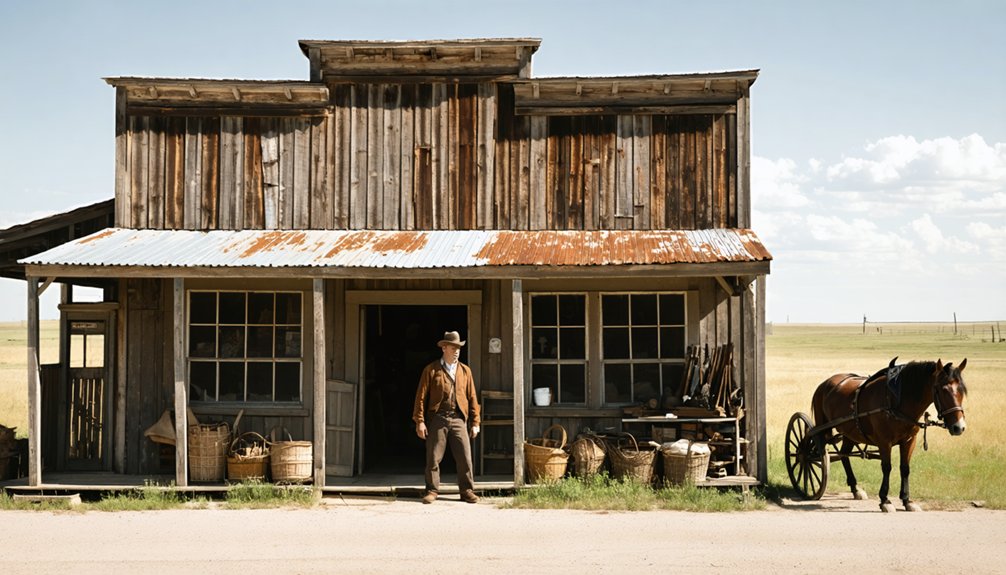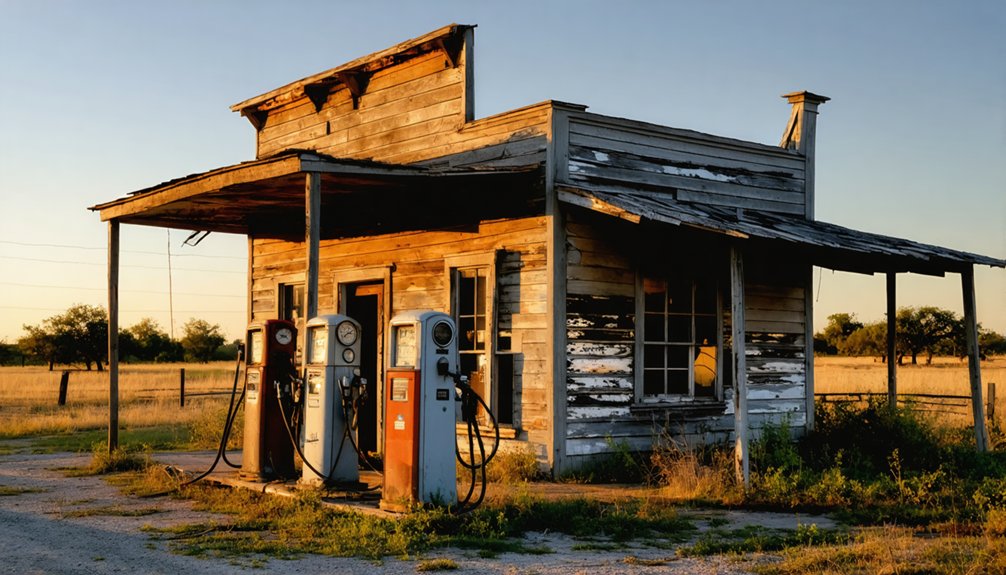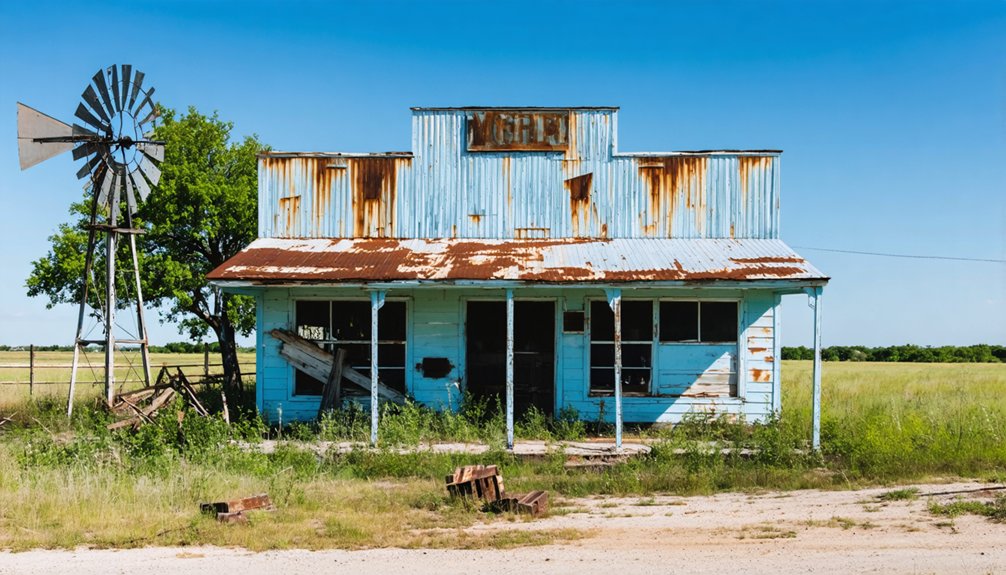You’ll find Dye Mound tucked away in Texas’s forgotten corners, where J.D. Bybee’s 1880 general store once anchored a bustling frontier trading post. This settlement weathered notable conflicts, including an 1870 skirmish with Kiowa chief Satanta, while serving as an essential hub for settlers and teamsters until the early 1900s. The town’s decline began with its post office closure in 1905, though its ancient dolomite mounds and rich frontier tales still echo across the Texas plains.
Key Takeaways
- Dye Mound was established in 1880 by J.D. Bybee as a trading post settlement with a general store in rural Texas.
- The community thrived around three main gathering spots: church (1890), schoolhouse (1878), and cemetery (1859).
- Post office closure in 1905 marked the beginning of Dye Mound’s decline from a bustling settlement to a ghost town.
- The schoolhouse, which served as a community hub for plays and meetings, closed in 1946, accelerating the town’s abandonment.
- Local organizations work with the Texas Historical Commission to preserve Dye Mound’s historical legacy and geological formations.
The Birth of a Frontier Settlement
While Native American tribes had long traversed the rich blackland prairies of southeastern Montague County, Dye Mound’s permanent settlement didn’t take root until 1880 when J.D. Bybee established his general store.
Long before Bybee’s store marked civilization in 1880, Native Americans roamed Dye Mound’s vast blackland prairies freely.
You’ll find the settlement’s origins tied to the promise of free or cheap land, drawing pioneers ready to stake their claim in Texas’ untamed frontier. Much like the El Camino Real route established by Spanish settlers in 1690, the area became an important pathway for new inhabitants.
The location’s natural springs and Trinity clay soil proved perfect for pioneer challenges, offering both water security and fertile ground for agricultural practices.
You’d have seen settlers working the dark soil while keeping watch from the area’s defensive high ground – a necessity given the ongoing conflicts with Comanche warriors. The area gained notoriety after a fierce battle between settlers and Chief Satanta’s warriors in January 1870.
The Texas government’s generous land grant policies, stemming from Spanish and Mexican traditions, let settlers claim substantial acreage for both farming and ranching operations.
Trading Post Origins and Early Commerce
You’ll find Dye Mound’s trading post sat at the crossroads of several frontier trade routes, connecting trappers, settlers, and Native Americans who traversed Montague County’s rugged terrain.
The post’s daily operations centered on bartering essential supplies, from trapping gear to household goods, while serving as a collection point for cotton and agricultural products from local farmers. Similar to how primary sources revealed W.W. Shepperd’s store was the actual trading post in Montgomery, historical documentation helps verify Dye Mound’s commercial activities. Founded in the late 1850s, the trading post became the cornerstone of the emerging community.
Teamsters moved goods between Dye Mound and larger markets via an intricate supply chain that relied on overland trails and ferry crossings until more advanced transportation methods emerged.
Early Frontier Trade Routes
As frontier settlements emerged across Texas in the 1850s, trading posts became essential hubs of commerce and community development. Dye Mound began with a local trapper’s outpost, establishing itself as an important stop along regional trade networks.
You’ll find the early trade routes faced significant challenges that shaped how goods moved across the frontier. Like ancient textile traders before them, merchants would transport natural dyes gathered from local roots, berries and bark to sell at frontier posts.
Here’s how trade operated in those days:
- Overland trails served as primary routes, with teamsters hauling cotton and supplies between isolated settlements.
- Rivers like the Brazos provided water transport, though sandbars and flooding made navigation treacherous.
- Trading posts strategically positioned themselves along these routes to serve travelers and local farmers.
- Horse-drawn wagons dominated transportation until railroads arrived, revolutionizing how goods moved across Texas.
You’d see traders carefully choosing routes based on natural landmarks and water sources, adapting to the harsh realities of frontier transportation while building the backbone of Texas commerce.
Trading Post Daily Operations
Among the earliest frontier trading posts, Dye Mound’s operation stands out as a reflection of Texas entrepreneurship in the 1850s.
Trading post management centered on facilitating essential commerce between settlers and travelers at the foot of Montague County’s hills, where you’d find necessary supplies for frontier living.
You’d witness daily barter practices as local farmers brought their cotton harvests to exchange for tools and provisions. The post served as more than just a commercial hub – it was your connection to the wider market and a gathering place for the community.
Despite challenges like harsh summers and limited transportation, the trading post adapted to seasonal agricultural cycles and shifting market demands, maintaining critical supplies for the region’s hardy settlers until railroad expansion eventually diminished its significance.
Supply Chain and Commerce
The origins of Dye Mound Trading Post trace back to a resourceful trapper in the late 1850s, whose legacy would shape the community’s name and commercial foundation.
Much like the successful traders at Red River Station, Dye Mound merchants facilitated vital commerce between settlers and regional populations.
You’ll find the trading post’s supply chain dynamics reflected its strategic position at the foot of Montague County hills, where it served as a crucial hub for regional commerce.
The commerce evolution of Dye Mound followed these distinct phases:
- Early trapping and fur trading operations established initial commercial routes
- Cotton farming emerged as the dominant economic driver by the late 1800s
- Overland teamsters connected the post to broader regional markets
- Integration of postal services in 1884 strengthened trade networks
You can trace the community’s growth through its transformation from a frontier trading post into an agricultural nexus, highlighting Texas’s free-market spirit and entrepreneurial heritage.
The Historic Battle With Satanta’s Warriors
During January 1870, one of the most remarkable frontier skirmishes unfolded near Dye Mound in Montague County, Texas, when three determined settlers faced off against the legendary Kiowa war chief Satanta and his band of nine warriors.
You’ll find this Dye Mound Skirmish showcased the fierce determination of both sides, as W.A. Morris, Holloway Williams, and Levi Perryman engaged in a three-mile running battle with the war party.
Satanta’s leadership proved vital as he rallied his warriors to charge, though the settlers’ tactical retreat and counterattack ultimately prevailed. The chief’s imposing presence as a six-foot tall warrior made him an intimidating sight on the battlefield. After being released from imprisonment in 1873, Satanta had immediately returned to raiding settlements.
The encounter demonstrated the complex nature of frontier warfare, where small groups often clashed in hit-and-run engagements that helped shape Texas history.
During the fight, the settlers even managed to wound Satanta’s horse.
Daily Life in Early Dye Mound

In early Dye Mound, you’d find J.D. Bybee’s general store serving as both trading post and social center, where farmers exchanged goods and shared news of the day.
You could witness local families gathering regularly at the chapel for worship services and community fellowship.
As a small frontier settlement, you’d see neighbors helping neighbors through shared meals, barn raisings, and the mutual support necessary for survival in rural Texas. The community relied heavily on sustainable practices to maintain their resources and livelihoods.
Trading Post Activities
Located at the foot of the hills in Montague County, Dye Mound’s trading post emerged as an essential commercial hub in the late 1850s when a local trapper established the settlement’s first business venture.
You’d find the trading post buzzing with activity as settlers, trappers, and Native Americans engaged in trading post barter, exchanging local cotton and pelts for frontier goods.
The post’s daily operations included:
- Supplying essential items like tools, ammunition, and clothing to pioneers
- Serving as a gathering spot for news and information exchange
- Coordinating transport of goods with local teamsters
- Acting as a collection point for agricultural products bound for larger markets
The post’s influence extended beyond commerce, shaping Dye Mound’s development until railroads redirected trade routes elsewhere.
Community Social Gatherings
Life in early Dye Mound revolved around three main gathering spots – the church founded in 1890, the schoolhouse built in 1878, and the three-acre cemetery established in 1859.
You’d find community celebrations centered around the cotton farming calendar, with social traditions tied to planting and harvest seasons. The schoolhouse hosted plays and town meetings until 1946, while the church organized regular religious services and special events that brought folks together.
You’d catch up on news and share stories at these gatherings, especially before the post office closed in 1905. Residents would travel by horse between Saint Jo, Forestburg, and Montague for social visits, maintaining connections with neighboring settlements.
The trading post also served as a popular meetup spot during the town’s early days.
Sacred Grounds: The Dolomite Mounds Legacy
Rising majestically above the Texas plains, the dolomite mounds near Chillicothe stand as ancient sentinels of geological and cultural heritage.
These sacred geology formations, composed of calcium magnesium carbonate, tell a story that’s 260 million years in the making. You’ll find their cultural significance deeply rooted in Native American history, particularly among the Comanche people who treasured these lands.
Here’s what makes these mounds extraordinary:
- They’re remnants of an ancient shallow sea, formed from marine life during the Permian period.
- Their distinctive white boulders and conical shapes create unmistakable landmarks.
- They’ve served as spiritual refuges and sources of medicinal herbs.
- Their dolomite composition has protected them from erosion, preserving Texas’s rich paleoenvironmental story.
From Bustling Hub to Abandoned Town

Though its name lives on through a weathered cemetery and scattered ruins, Dye Mound‘s transformation from a thriving frontier settlement to a ghost town mirrors the fate of many Texas communities.
You’ll find the echoes of community resilience in its history, from the establishment of essential institutions like the post office, church, and school in the late 1800s to the determined cotton farmers who worked the land during the town’s peak years.
Yet despite the settlers’ economic adaptation efforts, Dye Mound couldn’t escape the changing tides of the 1920s.
The post office’s closure in 1905 marked the beginning of decline, followed by the school’s shutdown in 1946.
Preserving Dye Mound’s Historical Heritage
Despite the passage of time, dedicated preservation efforts guarantee Dye Mound’s historical legacy endures through strategic partnerships between the Texas Historical Commission and local organizations.
When you’re looking to support preservation strategies in this historic Texas settlement, you’ll find multiple ways to get involved:
- Join local historical commission initiatives that document and protect remaining structures and artifacts
- Support cemetery preservation efforts that safeguard genealogical records and cultural heritage
- Participate in community-driven advocacy campaigns for national or state-level historic designations
- Contribute to coalition-building efforts that mobilize resources for site protection
Your community involvement makes a difference as preservation teams work to protect Dye Mound’s remaining features from urban development and natural threats, ensuring this piece of Texas heritage survives for future generations to explore and understand.
Frequently Asked Questions
What Natural Resources Were Found in the Dye Mound Area Besides Dolomite?
You’ll find nature’s treasures like iron ore and limonite, along with sandstone deposits and mineral springs. Brown iron ores were prominent, formed through weathering of greensand and iron carbonate deposits.
How Many Families Lived in Dye Mound During Its Peak Population?
You’ll find that during peak population dynamics around 1892, roughly 30-37 families called this place home, fitting the typical rural Texas community structure with households averaging 4-5 members each.
Were There Any Schools Established in Dye Mound?
You’re barking up the wrong tree if you’re seeking definitive school history in Dye Mound. While education impact was likely significant, no documented evidence confirms schools were established there.
What Happened to the Original Trading Post Building?
You won’t find the original trading post building today – it’s completely gone. While its trading post history shaped early Dye settlement, time and abandonment led to its natural decay or demolition.
Did Any Famous Outlaws or Lawmen Visit Dye Mound?
You won’t find any documented outlaw legends or lawman encounters at this location. Historical records don’t show famous outlaws or lawmen ever visiting – the town’s main conflict involved Native American warriors.
References
- https://www.forttours.com/pages/dyemound.asp
- https://www.hipcamp.com/journal/camping/texas-ghost-towns/
- https://www.findagrave.com/cemetery/3321/dye-mound-cemetery
- https://www.ghosttowns.com/states/tx/dyemound.html
- https://www.therainwatercollection.com/reference/1561.pdf
- https://en.wikipedia.org/wiki/List_of_ghost_towns_in_Texas
- https://www.youtube.com/watch?v=NdZOFY-u2AQ
- https://www.texasescapes.com/CentralTexasTownsNorth/Dye-Texas.htm
- https://texashistory.unt.edu/ark:/67531/metapth752794/m2/1/high_res_d/Between _the_Creeks_by_Gwen_Pettit_compiled_by_Melinda_Fisher.pdf
- https://www.thestoryoftexas.com/discover/texas-history-timeline



